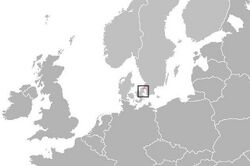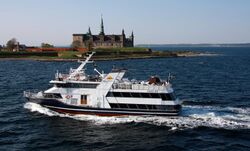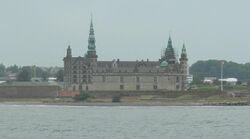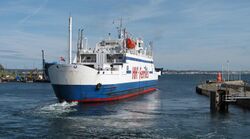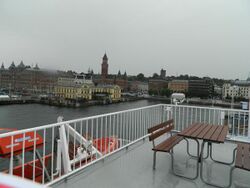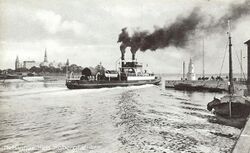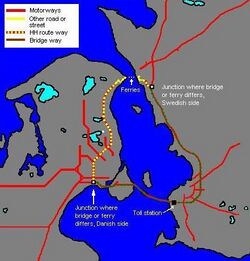Engineering:Helsingør–Helsingborg ferry route
The Helsingør–Helsingborg ferry route ("HH route") is a shipping route connecting Helsingør (Elsinore), Denmark and Helsingborg, Sweden across the northern, and narrowest part of the Øresund. Due to the short distance, which is less than 3 nautical miles, is it one of the world's busiest international car ferry routes, with around 70 daily departures from each harbour. The oldest-known written mention of the route dates to the German traveller Adam of Bremen in the 11th century, but it has likely been in use much longer. Before 1658, the route was a domestic Danish route. For several centuries, the route has been run regularly by various Danish shipping lines. Its significance grew during the 1950s, but since the inauguration of the Øresund Bridge in 2000, at the southern end of the Øresund, it has lost some significance but remains as one of the world's most important ferry routes, particularly as a cheaper alternative to the bridge tolls. Since 1952, passports have not been required for citizens of the Nordic Passport Union countries. Since 2001, when both countries became members of the Schengen Area, passports are not needed for anyone.
Current traffic
The route is currently served by car ferry shipping line Scandlines new name is Öresundeslinjen and a smaller passenger shipping line known as Sundbusserne[1] ("The Sound Buses"). Scandlines' now a days Öresundslinjens ferries departure more than 70 times daily, from each port. Every 20 minutes for most of the day, and for cargo with an additional ferry.[2] As the distance between Denmark and Sweden here only is around 2.5 nautical miles (approx. 4 km), the crossing time is just 20 minutes.[3] While Sundbusserne, currently (as of January 2015) departs every hour with their only "bus".[4] (During the summertime, every half hour when Jeppe is plying the route).
Scandlines/todays Öresundslinjen uses four ferries, MF Tycho Brahe, MS Aurora, MF Hamlet and MF Mercandia IV.[5] The M/F Mercandia VIII is available and used during the annual maintenance of the other ferries and during the July peak weeks.[6]For now buth Mercandia IV and VII is only for cargo or in reserve. The three first mentioned ferries are sister ships and were tailored for this short route. In the year of 2018 MS Aurora and MF Tycho Brahe they start running on electricity. They use dual command bridges and lack natural prows and sterns (nor starboard and port side) and hence never need to turn. Aurora, Hamlet and Tycho Brahe are also built rather low (relative to sea level) and very wide. The Mercandia IV and Mercandia VIII sister ships were not built especially for this particular route, being vessels of the so-called Superflex type, and have a single bridge. As the bridge is located in the middle of the ship, they also do not need to turn around to change east/west travel direction. Although Mercandia IV and Mercandia VIII look very different from the other three ferries, all five ferries fit within the same category, which allows fastest possible return time.
The crossing takes 20 minutes and the vessels only need 10 minutes in port, so the same ferry regularly departs from both ends of the route inside every hour. This is not the same for Mercandia IV as only take trucks cargo. Therefore the ferry does not run at exactly 15 minute intervals, and there is a separate timetable for trucks.
Sundbusserne currently (as of February 2015) uses only the Pernille, a passenger boat for around 200 passengers. A smaller bar is located at its prow and astern two decks are available for passengers. All Scandlines' vessels have cafeterias, bars, shops and Aurora also has an additional a la carte restaurant. This is not intended for travelers, but more for local residents and others who makes one or more immediate return journeys (passengers do not need to leave the ships in port). Double or even triple return voyages are not uncommon. Locally this has spawned a new word (a verb)—to "tura" (Swedish) or to "ture" (Danish), which simply means "making at least one return trip for fun".
In each city, the ferry terminals are directly connected to the main railway stations. Trains depart from Helsingør to Copenhagen four to seven times per hour and arrive at Copenhagen Central Station after 38 or 55 minutes (at more northern Copenhagen stations such as Østerport faster).[7] Two different local train lines depart from Helsingør station. Both lines end in Hillerød, but one of them takes an indirect path, first along the North Zealand coast. From Gilleleje, the tracks turns to the south and pass through Gribskov, one of Denmark's largest forests. The short route takes 20 minutes to Hillerød, the long route 80 minutes.
In Helsingborg, the ferry terminal is connected to an underground railway station and an overly grand station nearer the bus station. The entire building is known as "Knutpunkten", "The Junction". The total number of passengers from trains and ferries makes it one of the busiest stations in Sweden. Around 50.000 passengers (including those in cars and lorries) use "Knutpunkten" every day.[8] Helsingborg is located on the Swedish West Coast Main Line ("Västkustbanan"), but the first 25 km north of "The Junction" station (until Maria), only consist of a single track railway, which have some very sharp bends and a steep elevation in the northern part of the city.[9] The interregional Øresund trains departs to Gothenburg, through Landskrona, Lund and Malmö across the Øresund Bridge to Copenhagen. Hence it is possible to make a full journey around the Øresund by the use of trains and the HH Ferry route. Local Pågatågen also departs from "The Junction", in four directions.
In 2017 Scandlines began a project which is aiming for electrical power through huge batteries, in order not to emit greenhouse gases and other pollutants.[10] The old oil (or diesel) burning engines will mainly be used to charge the batteries. The final intention however, is to abandon the old engines totally. The initial part will for instance reduce the carbon dioxide emissions by 50 percent.[11]
History
Early history
There is proof of traveling across the northern part of Øresund from earliest possible historical times, or since the Christianisation of the Vikings (in Denmark from around 985, according to the larger Jellinge Stone). The oldest-known historical text about travels across Øresund derives from the German history writer Adam of Bremen, who around 1070 wrote "From Zealand to Scania are many well used crossings, of which the shortest leads to Helsingborg."[12]
Danish and Kalmar Union King, Eric of Pomerania introduced the Sound Dues in 1429. This charge were to be paid to Denmark by every ship that passed through Øresund. They were at the time mainly enforced as a disadvantage to the Hansa, but soon became an important source of income for Denmark for the following hundreds of years. Helsingør became a flourishing and famous town. William Shakespeare unfolded his famous play Hamlet (written 1599–1601; first printed in 1602) at Helsingør and Kronborg Palace.[13] At the end of medieval times, Kronborg was a fortress (completely rebuilt during the early Renaissance) and until 1658 the Danes had a complete view across the narrow northern part of Øresund. It was not only from Kronborg they could watch ships, but also from the tower in Helsingborg, known as Kernen. The Sound Dues were to last until 1857—with exception for Swedish ships between 1658 and 1720—when international complaints initiated economic and political agreements.[14][15]
Fishers and ships that crossed the Øresund were not passing through, and were hence not affected by the Sound Dues. Before 1658, ships could pay their commission both sides of the narrow strait which constitutes the Northern part of Øresund. After the Swedish conquest of Scania, the ships which were bound to pay the charges needed to anchor just south of Kronborg Castle, as Sweden had never been allowed to take any dues. The sheltered location just south of Kronborg, where ships anchored in order to pay the Sound Dues, are the ferry berth of Helsingør today.
Renaissance to 19th century
King Frederick I decided in 1524 that Elsinore would exempt from paying royal taxes, on the condition that "his people" should be shipped across the route for free. This was a heavy burden on the people of Elsinore during wartime.[16]
In 1630 the ferry route was established and a "ferry team" was created. The size of the ferry crews and the fares were regulated by law. Contrary to other ferries within the Kingdom of Denmark, the "Helsingør færgelaug" (Helsingør ferry team) received all rights to sail the route as a vague monopoly. The ferry team was also awarded a part of the Sound Dues for ships that also used the ferries for parts of their cargo.[12]
In 1836 a shipping line began to use the paddle steamer Maria on the route. This was not well liked by "Helsingør færgelaug", who complained in defence of their 200-year-old privileges. The ferry men won in court. From 1840 "Helsingør færgelaug" received a legal monopoly on the route. But times were about to change with the industrial revolution.[12]
The "Helsingør færgelaug" continued until 1882, when Christian IX formally abolished the monopoly. However, in practice the monopoly was abandoned already by 1874, as Denmark's largest shipping line at the time had begun to operate on the route.[12]
Regular ferry history
From 1874 the monopoly instead went to "Det Forenede Dampskibs-Selskab" (The United Steamship Company), which probably is more known as DFDS.[17] Fourteen years later, in 1888, private ownership was abandoned, as "De Danske Statsbaner" the Danish national railways or DSB took over the service. Although the monopoly was formally abandoned already in 1874, DFDS never attempted to compete with nationally owned DSB. As a railway company, DSB surely was thinking of a train ferry line already from scratch. However between 1888 and 1892 they only operated the ship Masnedsund, which apart from pedestrian passengers only transported mail. But four years later, on 10 March 1892,[18] did DSB open its train ferry route (open also for pedestrian passengers). No less than three paddle-streamers for trains were taken in use, Kronprinsesse Louise (in 1892), Thyra (in 1893), Kronprins Frederik (in 1898) was in operation before the end of the 19th century. And the first ship to use a propeller, Helsingborg (in 1902) was of course also a train ferry. The ferry crossing became a part of the "classical" train line between Copenhagen and Oslo and later also night trains to Stockholm.[19]
The route was from its beginning a totally Danish matter (though some cars of the trains could belong to Norwegian NSB), first by 1931 did the Swedish counterpart to DSB, Statens Järnvägar or SJ involved. This was done through a deal which got the label "Midtsunds-trafikoverenskomst" (in Danish). DSB and SJ should from this year split all revenues and spending between them equally. The running of the HH ferry route was, however, still managed by DSB.[20]
During the First World War the southern Øresund was mined by Denmark, Sweden and the German Empire at the request of the latter[21] but the northern and central parts of Øresund were not affected by this and the traffic could continue.
During the Second World War, Denmark, despite their neutrality, become occupied by Germany on 9 April 1940, known as "Besættelsen" in Denmark.[22] In the beginning of this occupation the Germans expected the Danish society to keep working as usual. The ferries continued to sail, but with reduced number of departures.
Competition begins
An important date for the Øresund crossing was 13 July 1952, as passports were no longer needed for travel between the Scandinavian countries and Finland, due to the Nordic Passport Union.[23]
It was in 1955 that any Swedish shipping line first became interested in competing with DSB on the route. It was the bus company Linjebuss AB which from then also became a shipping line. The new ferries become known as LB.[24]
From 13 July 1952, passports were no longer needed for traveling between Sweden and Denmark.[25][26] This was soon extended also to Norway in 1954[27] and eventually also within entire Scandinavian countries and Finland.[28] And from the mid-1950s a golden era began as cars had become more common, people could afford holidays (and Copenhagen Airport has since passenger aviation began been the main airport also for southern Sweden). But also pedestrian passengers became more and more common.
DSB had the same year as LB started to compete put the new M/F Helsingør on the route and later followed her sistership M/F Hälsingborg. Both had dual railway tracks on board, located laterally along the center of the ships. To the left and the right were space for a few cars, lorries could not be shipped together with trains, however. But a strange solution for the cafeteria and toilets, below car-deck, made these ferries notably unpopular. However, M/F Hälsingborg[29] and M/F Helsingør[30] became the first ferries on the route which did not need to turn.
LB challenged DSB with a rather different concept, M/S Betula was despite she was 26 years old, when she became first challenger on the route ever in 1955.[31] Betula had a natural prow and stern, and hence needed to turn twice on the way from Helsingør to Helsinborg, if the cars, lorries and buses should not need to drive off the ferry backwards. LB would continue with that concept as long as they sailed the route. In Helsingborg the vehicles drove on board through the stern, and then drive off through the opened prow in Helsingør. The earliest LB ferries had the cafeterias well above the car deck which was the difference between watching the sea or perhaps feeling a bit claustrophobic.
Helsingør Town was not too happy about the Swedish privately owned LB; the main trouble was the increased traffic that drove to the LB ferries. While the DSB terminal was built together with Helsingør's main train station, LB had to (by time) build two smaller terminals on the opposite pier. Which also was on the small road to Kronborg Palace. The LB terminals also caused ever-increasing traffic through central Helsingør and was generally disliked by Helsingør's local politicians. But the town simply had to accept the competition from LB.
Just three years after LB established their line, in 1958, did Sundbusserne, small ships or "Sound Buses" (which could not carry cars, lorries or trains), began to operate on the route.[32] Sundbusserne made the route "all-Scandinavian" as they sailed under Norway , LB under Swedish ones and DSB under Danish ones.
From around 1960 a kind of "golden era" began at the route. Both shipping lines ordered more and larger ferries. LB put M/S Primula in operation this year.[33] By 1973 LB had replaced their first two ferries with four new ones M/S Carola 1964,[34] M/S Betula (the second) 1968, rebuilt in 1985,[35] M/S Regula 1971, rebuilt 1985[36] and M/S Ursula 1973, rebuilt 1985.[37] Betula (II), Regula and Ursula were sisterships, while Carola externally was a sistership to M/S Dana Scarlett, a ferry that mostly operated on the route between Landskrona and Copenhagen, 25–40 km further south.[38]
Also DSB ordered new ferries, larger, more pleasant for passengers and which could take lorries and train simultaneously. However they kept M/F Helsingør and M/F Hälsingborg as well. The four sister ships M/F Najaden,[39] M/F Kronborg,[40] M/F Kärnan[41] and M/F Holger Danske.[42]
By the middle of the 1970s LB departed every 20th minute from each port, with their four ferries, DSB every 15th minute with their six ferries, and so did the Sundbusserne. On top of that an older ship called Marina sailed every hour from Helsingborg to Snekkersten just a few kilometers south of Helsingør's port.[43] In all 12 departures from Helsingborg every hour during day time and early evenings.
LB operated also two other ferry routes, SL ferries operated at the central part of Øresund, between Landskrona and the northern Copenhargen port, Tuborg (owned by the Tuborg brewery) as well as a route from Helsingborg through Copenhagen Tuborg and Travemünde, Schleswig-Holstein, Federal Republic of Germany (The latter line was only used from either Helsingborg or Copenhagen, Tuborg to Western Germany, not between Helsingborg and Copenhagen). The three sister shipping lines were labeled as the LB/SL/TL ferries, where SL meant "Skandinavisk Linjetrafik"[44] (Scandinavian Line Traffic) and TL meant "Trave Line".[45][46]
End of the "golden era"
The 1973 energy crisis and higher oil prices affected the Øresund crossing routes, from huge profits the privately owned shipping lines got financial difficulties.
TL or Trave Line was the first to be closed down, this was in 1976.[46] And LB's headquarters in Stockholm decided to move the SL ferries, which had sailed between Landskrona and Copenhagen Tuborg every hour or 90th minute since 1954 (crossing time was 70 minutes), to Malmö in an attempt to increase their profits ended already after eight months only.
In October 1980 LB's headquarters in Stockholm decided to move the SL ferries from Landskrona to Malmö, but they still sailed to Copenhagen Tuborg Danish side. This made the crossing time 20–25 minutes longer (much due to the flat island Saltholm and its surrounding shallow waters), and the already existing route between Limhamn (a borough in southern Malmö with a port of its own) and Dragør (just south of Kastrup Airport) had a crossing time of just 50 minutes.[47] And already eight months the SL ferries closed down. The move to Malmö was an obvious mistake.
In the following year, 1981, LB merged with the shipping line which from 1960 had begun to operate in the southern part of Øresund between Dragør and Limhamn, Dampskibsselskabet Øresund A/S[47] and the new shipping line name became Scandinavian Ferry Lines or simply SFL,[48] which now operated the HH route as well as the Dragør–Limhamn route.
The end of the train ferries
All goods trains were removed from the route in November 1986, as two large goods-train ferries began to operate between Helsingborg harbour's western port (Swedish: Västhamnen) and the north port (Danish: Nordhavn) in Copenhagen. The huge goods train ferries were sister ships, the Danish M/F Trekroner, and the Swedish M/S Öresund[49] were operated by DanLink[50][51] until the opening of the Øresund Bridge in July 2000. But the passenger train line Copenhagen–Oslo continued to be using the DSB ferries across the HH route until the bridge opened 1 July 2000. Ironically, the so-called Linx trains between the Danish and Norwegian capitals went into bankruptcy a year later.
End of competing (cars and lorries)
In 1984 Helsingborg City Council and the Swedish government decided to replace the city's two railway stations with one. The single track from north was split up underground and connected to the railway from the south. It was also decided to move DSB's ferry terminal to SFL's. The new combined railway station and ferry terminal got the name "Knutpunkten", or "the Junction".[48] Also in Elsinore SFL's two smaller ferry terminals would be demolished, located at the Kronborg pier, the SFL (and LB before them) terminals had caused a major traffic problem in the Danish town. All ferries from Elsinore should just like in Helsingborg leave from one single terminal. And also Elsinore station and ferry terminal was enlarged. The port was not expanded for more ferries, but the area just south of Helsingør port is usually calm enough to handle larger ships. Hence a space for two ferries was constructed on the outer side of the southern pier.
Towards the end of "the old order", DSB finally replaced the "U-boats" M/F Helsingør and M/F Hälsingborg, which both had cafeterias below car deck, with ferries that had sailed on the Aarhus–Kalundborg route. They were M/F Prinsesse Anne-Marie and M/F Prinsesse Elisabeth.
In 1991, when the new ferry terminals were inaugurated, the operators, DSB (the Danish National Railways) in cooperation with its Swedish counterpart SJ, and privately owned SFL began to cooperate. This meant the end of competition on the route. Also the names of the operators changed from DSB and SFL to Scandlines.[48] The Sundbusserne still existed, but could only carry pedestrian passengers.
The remodeled ferry terminals could not handle both SFL's former four ferries together with DSB's former six ones,[52] instead three longer and wider ferries were ordered. The first delivered was M/F Tycho Brahe (1991) thereafter M/S Aurora (1992)[48] but the third sister ferry was delayed, as the Danish and Swedish governments had signed the deal to build the Øresund Bridge. In order to maintain the capacity, two larger former DSB ferries from Great Belt complemented the Scandline fleet temporarily. M/F Hamlet arrived in the mid-1990s.
From 2019 Scandlines has changed name to "Forsea Ferries".[53]
ACE-link and Sundbusserne
Sundbusserne was sold in the autumn of 2006, the buyers were another Norwegian shipping line, Eitzen Holdings, and by May 2007 was the name shifted to Ace link. In 2008, a large investment in two notably bigger passenger ships failed, and early in 2010 ACE-link went bankrupt. But soon a new shipping line "Sundbusserne af 2010" (The Sound Buses of 2010) was founded and has since used the original shipping line's boat Pernille.[54]
The period of renewed competition
After complaints of high prices, Denmark enforced a new law in 1996. According to this law half of the terminal in Helsingør was expropriated in order to re-establish a second competing shipping line on the route.[48] Hence could HH Ferries begin to compete with Scandlines. In Helsingborg they already had found a location for a new terminal. This was at a distance from the city centre, a remote and far from optimal location for pedestrians. However, for cars and lorries the location did not cause any problem. HH Ferries opened in 1996 using two so called superflex ferries, M/F Mercandia IV and M/F Mercandia VIII.[48]
However, after a larger cooperation bought Scandlines and through the purchase of the owners of HH ferries, suddenly both Scandlines and HH Ferries became two parts of one and the same cooperating group and the supreme management soon afterwards decided to close HH Ferries again. As of January 2015 Scandlines remains as the single operator of cars and lorries at the route.
In 2015, HH ferried 7.4 million passengers, 1.4 million cars, 390,000 lorries and 20,000 busses. Two of the four ferries are scheduled to be converted to full electric propulsion with 4 MWh batteries each, being recharged from land by a robot when docked.[55]
As of 2023, vehicle ferry services are provided by Øresundslinjen with a passenger-only service from Sundbusserne.[56]
The Øresund Bridge vs. the HH Ferry route
After Scandlines as new owners of HH-Ferries closed the latter shipping line, prices went up. For less frequent drivers and their passengers, the single and return prices with Scandlines are almost exactly the same as on the Øresund Bridge (summer 2015). The driving distance, if using the fixed connection, is notably longer though. For people living close to the HH route, return tickets prices equals the single ticket (half the price)—but the return travel must begin prior to midnight. Lorry and bus companies usually have special deals with Scandlines.
The future
There are proposals for road and multiple rail tunnels across the route as well as partial bridge options. None of the proposed alternatives have a schedule or funding. The proposals have, to date, received greater political priority from Sweden than Denmark.
List of operators
- Helsingør Færgelaug, ("Elsinore Ferry Team"), 1630–1882
- Paddle steamer "Maria", 1836–1840
- DFDS, 1874–1888
- DSB, 1888–1991
- LB, Linjebuss International, 1955–1981
- Sundbusserne 1958–2007, 2010–
- ACE-link 2008–2010
- Scandinavian Ferry Lines, SFL 1981–91
- Scandlines 1991–2018
- HH Ferries 1996–2013
- ForSea Ferries 2018–2023
- Öresundslinjen 2023-
References
- ↑ "Home". http://sundbusserne.se/.
- ↑ Note! Scandlines have several shipping routes, look at "Helsingør-Helsingborg" at http://www.scandlines.com/tickets-und-tarife/tickets-and-prices.aspx
- ↑ same, Scandlines
- ↑ "Fartplan & Priser". http://sundbusserne.se/fartplan-priser.html.
- ↑ Bottom of the complete timetable; PDF http://www.scandlines.dk/~/media/Scandlines/ScandlinesDk/Docs/Tidtabell-HH-sep-dec-2014.ashx
- ↑ The vessel in question is usually located at "the Ocean port" of Helsingborg port, it's painted in Scandlines colours
- ↑ http://borupgaardnet.dk/pdf/20010515144938.pdf [bare URL PDF]
- ↑ Helsingborgs stad (2003), stadskärna: Bevarandeprogram 2002, page 156. Helsingborg: Helsingborgs stad. ISBN:91-631-3664-3
- ↑ Last part of http://www.trafikverket.se/Privat/Vagar-och-jarnvagar/Sveriges-jarnvagsnat/Vastkustbanan/ "Enligt vår nuvarande planering kommer utbyggnaden till största delen vara klar 2012–2014. Några sträckor kommer då att återstå, bland annat sträckan genom Varberg och sträckan Ängelholm–Helsingborg. Tunneln genom Hallandsås planeras vara klar 2015." No dual tracks between Helsingborg and Ängelholm exists
- ↑ "Vi laddar upp för batteridrivna färjor mellan Helsingborg-Helsingör". https://www.scandlines.se/om-scandlines/batteridrivna-farjor.
- ↑ "Home". http://seglamedstrommen.se/.
- ↑ 12.0 12.1 12.2 12.3 http://www.helsingorleksikon.dk/index.php/Helsing%C3%B8r-Helsingborg_overfarten (in Danish)
- ↑ "Øresundstolden". http://www.danskskaanskforening.dk/DST/2-05-oresundstolden.htm.
- ↑ "Øresundstolden" (in Danish). http://www.danskskaanskforening.dk/DST/2-05-oresundstolden.htm.
- ↑ "Elsinore and the Danish sound dues". History today. http://www.historytoday.com/oliver-warner/elsinore-and-danish-sound-dues.
- ↑ (source states nothing about Helsingborg, which still would be a part of Denmark for many years to come) http://www.helsingorleksikon.dk/index.php/Helsing%C3%B8r-Helsingborg_overfarten
- ↑ After third headline at http://www.helsingorleksikon.dk/index.php/Helsing%C3%B8r-Helsingborg_overfarten "Dampskibenes æra" which means "The era of the steamships"
- ↑ "Färjetrafik" (in Swedish). Helsingborg City Encyclopedia. 8 December 2016. https://stadslexikon.helsingborg.se/frjetrafik/. Retrieved 11 February 2021.
- ↑ fifth headline at http://www.helsingorleksikon.dk/index.php/Helsing%C3%B8r-Helsingborg_overfarten
- ↑ After fourth headline, lower part, at http://www.helsingorleksikon.dk/index.php/Helsing%C3%B8r-Helsingborg_overfarten "De Danske Statsbaner overtager færgefarten"
- ↑ Swedish Encyklopedia "Nordisk Familjebok" 3rd edition, 1924-37 20 volumes + 3 supplementary 1937-39, volume 20, article "Öresund"
- ↑ "Besættelsen | lex.dk – Den Store Danske". Denstoredanske.dk. http://www.denstoredanske.dk/Danmarks_geografi_og_historie/Danmarks_historie/Danmark_1849-1945/Bes%C3%A6ttelsen. Retrieved 2022-05-27.
- ↑ "Oresundstid". Oresundstid.dk. http://www.oresundstid.dk/arkiv/arkivkilde.aspx?id=1135&tekst=Temaer. Retrieved 2022-05-27.
- ↑ "LB Færgerne - Helsingør Leksikon" (in da). Helsingorleksikon.dk. http://www.helsingorleksikon.dk/index.php/LB_F%C3%A6rgerne. Retrieved 2022-05-27.
- ↑ "Helsingborgs Hamn - Containerspecialisten". Port.helsingborg.se. 2021-12-16. http://www.port.helsingborg.se/allmanhet/farjetrafiken/. Retrieved 2022-05-27.
- ↑ "Oresundstid". Oresundstid.dk. http://www.oresundstid.dk/arkiv/arkivalt.aspx?id=1135&tekst=Temaer&standard=J. Retrieved 2022-05-27.
- ↑ "Nordisk passunion – Store norske leksikon". Snl.no. 8 September 2021. https://snl.no/Nordisk_passunion. Retrieved 2022-05-27.
- ↑ "Den nordiska passkontrollöverenskommelsen — Nordiskt samarbete". http://www.norden.org/sv/om-samarbejdet-1/nordiska-avtal/nordiska-avtal/passfraagor-medborgarskap-och-folkbokfoering/den-nordiska-passkontrolloeverenskommelsen.
- ↑ Second photo at http://www.kwmosgaard.dk/ferries/haelsingborg_1960.htm, information about the ferry - under the picture
- ↑ Note the same info as about MF Hälsingborg at http://www.kwmosgaard.dk/ferries/helsingoer_1955.htm
- ↑ "M/S Betula". Kommandobryggan.se. http://kommandobryggan.se/hh/betula.htm. Retrieved 2022-05-27.
- ↑ "Om Sundbusserne". http://sundbusserne.se/om-sundbusserne.html.
- ↑ "M/S Primula". Kommandobryggan.se. http://kommandobryggan.se/hh/primula.htm. Retrieved 2022-05-27.
- ↑ "M/S Carola". Kommandobryggan.se. http://kommandobryggan.se/hh/carola.htm. Retrieved 2022-05-27.
- ↑ "M/S Betula". Kommandobryggan.se. http://kommandobryggan.se/hh/betula68.htm. Retrieved 2022-05-27.
- ↑ "M/S Regula". Kommandobryggan.se. http://kommandobryggan.se/hh/regula.htm. Retrieved 2022-05-27.
- ↑ "M/S Ursula". Kommandobryggan.se. http://kommandobryggan.se/hh/ursula.htm. Retrieved 2022-05-27.
- ↑ "M/S Dana Scarlett". Kommandobryggan.se. http://kommandobryggan.se/hh/dana.htm. Retrieved 2022-05-27.
- ↑ Second photo at http://www.kwmosgaard.dk/ferries/najaden_1967.htm information about the ship below the photo
- ↑ Same as for "Najaden" at http://www.kwmosgaard.dk/ferries/kronborg_1973.htm
- ↑ Same as "Najaden" and "Kronborg at http://www.kwmosgaard.dk/ferries/kaernan_1970.htm
- ↑ Same as Najaden, Kronborg,Hälsingborg at http://www.kwmosgaard.dk/ferries/holgerdanske_1976.htm (There are a number of Danish ferries with this name, but this is the one which trafficked the HH-route)
- ↑ "Snekkersten-Helsingborg færgerute - Helsingør Leksikon" (in da). Helsingorleksikon.dk. http://www.helsingorleksikon.dk/index.php/Snekkersten-Helsingborg_f%C3%A6rgerute. Retrieved 2022-05-27.
- ↑ "Landskronaoverfarten.se". http://www.landskronaoverfarten.se/sl.html.
- ↑ "Skandinavisk Linjetrafik Ferry Postcards". Simplonpc.co.uk. http://www.simplonpc.co.uk/ScandLinjetrafik.html. Retrieved 2022-05-27.
- ↑ 46.0 46.1 "Trave Line Ferry Postcards". Simplonpc.co.uk. http://www.simplonpc.co.uk/TraveLine.html. Retrieved 2022-05-27.
- ↑ 47.0 47.1 "Dragør-Limhamnfærgen - Lokalarkiv". http://www.dragoer.dk/page4051.aspx.
- ↑ 48.0 48.1 48.2 48.3 48.4 48.5 "Helsingborgs stadslexikon | Helsingborgs stad". Stadslexikon.helsingborg.se. 2020-11-26. http://stadslexikon.helsingborg.se/index.php?title=F%C3%A4rjetrafik. Retrieved 2022-05-27.
- ↑ "M/F Öresund, DanLink Jernbanefærge på Øresund". http://www.hauerslev.com/danlink/materiel/faerger/oresund/index.htm.
- ↑ "DanLink | lex.dk – Den Store Danske". Denstoredanske.dk. 22 August 2013. http://www.denstoredanske.dk/Bil,_b%C3%A5d,_fly_m.m./Jernbane/Godstransport/DanLink. Retrieved 2022-05-27.
- ↑ ""Med Kunden i Centrum" - Historien om DanLink - DSB 1986-2000". http://www.hauerslev.com/danlink/index.htm.
- ↑ about their names and how many http://www.helsingorleksikon.dk/index.php/Helsing%C3%B8r-Helsingborg_overfarten#Bilf.C3.A6rgerne
- ↑ "Home". https://www.forsea.se/.
- ↑ "Sundbusserne - Helsingør Leksikon" (in da). Helsingorleksikon.dk. 2008-08-18. http://www.helsingorleksikon.dk/index.php/Sundbusserne. Retrieved 2022-05-27.
- ↑ Tore Stensvold (27 June 2016). "89 tonn batterier i verdens største el-ferge". Tu.no. http://www.tu.no/artikler/89-tonn-batterier-i-verdens-storste-el-ferge/348995. Retrieved 2022-05-27.
- ↑ Sydsverige.dk. Færger og bro til Sverige. Retrieved 4 November 2023.
 |

